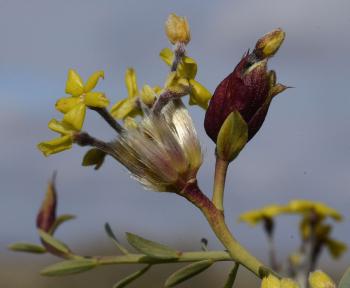Lasiosiphon rigidus
Lasiosiphon rigidus J.C.Manning & Boatwr.
Family: Thymelaeaceae
Common names: none recorded
Introduction
A small-leaved shrublet with fragrant, bright chrome-yellow flowers surrounded by vivid yellow bracts, flushed with dark red.

Description
Description
A rigid shrublet growing up to 1 m high, with divaricate, sparsely leafy branchlets, later developing a grey-fissured bark and becoming thorny. The obovate to oblanceolate, alternate leaves are leathery with a short petiole, 0.2–0.5 mm long.

Bright chrome-yellow flowers with a maroon tube are borne in terminal heads, surrounded by 5 papery bracts, either plain yellow or flushed wine-red or maroon; the bracts fall off at maturity exposing the long, silvery to golden, hairs. It flowers from June–September (winter to early spring).

Conservation Status
Status
Lasiosiphon rigidus is currently listed as Least Concern (LC) in the Red List of South African plants.

Distribution and habitat
Distribution description
Endemic to the central and eastern parts of the Tankwa Karoo, Western Cape, restricted to loamy soils on the banks and margins of seasonal and drainage lines.

Derivation of name and historical aspects
History
Lasiosiphon is derived from the Greek lasio, ‘woolly’ and siphon, ‘tube’, describing the floral tube. The specific epithet is derived from its rigid habit.
Lasiosiphon rigidus was previously misidentified as L. microphyllus (Gnidia microphylla) and is also closely related to L. polycephalus.
The genus was originally distinguished from Gnidia by its pentamerous flowers, but different authors disagreed with this separation. Lasiosiphon has recently been reinstated based on molecular studies, but now includes species with pentamerous and tetramerous flowers. Currently, 29 species of Lasiosiphon in southern Africa are recognized.
Ecology
Ecology
Some members of the genus are known to be pollinated by butterflies and beetles; however, no pollinators have been recorded for L. rigidus.
Uses
Use
No uses has been recorded, however, some species in the genus are reported to be toxic to livestock and others medicinally important. For example, Lasiosiphon kraussianus has been documented to be toxic whereas L. meisnerianus is used medicinally to treat fevers. The bright yellow flowers of some species, such as L. deserticola, were used culturally to dye leather.
It could make an attractive garden plant, especially in drier areas, if planted on the edge of the pathway, displaying its colourful flowers that emit a lilac-scented fragrance at night.
Growing Lasiosiphon rigidus
Grow
Lasiosiphon species are not well-known among the general public and not often cultivated. However, the techniques that have been used in cultivating members of Thymelaeaceae can be used in cultivation of Lasiosiphon. It has been suggested that tip pruning of Lasiosiphon may increase its attractiveness as a garden plant.
References
- Beaumont, A.J., et al. M. 2009. Gnidia (Thymelaeaceae) is not monophyletic: taxonomic implications for Thymelaeoideae and a partial new generic taxonomy for Gnidia. Botanical Journal of the Linnean Society 160: 402–417.
- Magee, A.R. & Manning, J.C. 2017. Lasiosiphon esterhuyseniae (Thymelaeaceae: Thymelaeoideae), a new species from Northern Cape (South Africa), and the transfer of two additional southern African species to the genus. Kew Bulletin 72:1.
- Manning, J.C. & Boatwright, J.S. 2013. Lasiosiphon rigidus (Thymelaeaceae), a new species from the Tankwa Karoo and two new combinations in the genus for South Africa. Bothalia 43: 84–88.
- Manning, J. & Goldblatt, P. 2012. Plants of the Greater Cape Floristic Region 1: the Core Cape Flora. Strelitzia 29. South African National Biodiversity Institute, Pretoria.
Credits
Refilwe Kolokoto & Thuli Makhoba
Compton Herbarium
October 2017
Photos: John Manning
Plant Attributes:
Plant Type: Shrub
SA Distribution: Western Cape
Soil type: Sandy, Loam
Flowering season: Spring, Winter
PH: Acid
Flower colour: Yellow
Aspect: Full Sun
Gardening skill: Challenging
Special Features:
Horticultural zones









Rate this article
Article well written and informative
Rate this plant
Is this an interesting plant?
Login to add your Comment
Back to topNot registered yet? Click here to register.